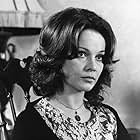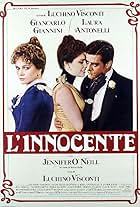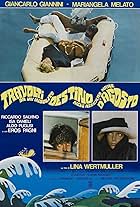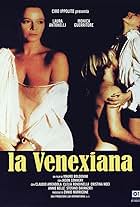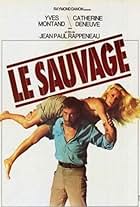Una bella donna ha rapporti con due uomini, costringendoli a confrontarsi.Una bella donna ha rapporti con due uomini, costringendoli a confrontarsi.Una bella donna ha rapporti con due uomini, costringendoli a confrontarsi.
- Premi
- 2 vittorie e 2 candidature
Mary Ruth League
- Dany's Friend
- (as Ruth League)
Trama
Lo sapevi?
- QuizFinal film of Doris Duranti.
- ConnessioniReferenced in Io sono un autarchico (1976)
Recensione in evidenza
Is there any other film that sums up 'Divine Decadence' as lusciously as this? Better films, perhaps. Deeper films, most definitely. Yet for succulent visual splendour, Giuseppe Patroni Griffi's tale of decaying 1920s nobility takes a lot of beating.
As a womanising aristocrat who falls prey to a hopeless love, Terence Stamp bears an eerie resemblance to Boldini's portrait of Robert de Montesquiou, the real-life model for Marcel Proust's doomed aesthete the Baron de Charlus. The story too unfolds along Proustian lines. Meeting a 'respectable' middle-class girl (Laura Antonelli) and her none-too-bright fiance (Michele Placido) Stamp loses his heart - only to learn she is really a high-class prostitute.
This being an Italian film, his growing obsession takes on a darker and more melodramatic tone than anything in Proust. Stamp makes an abortive bid to poison his lady-love, infiltrates her brothel as an anonymous client and manoeuvres her into a twisted sexual triangle with his unsavoury, Fascist-sympathising cousin (Marcello Mastroianni). As we may expect, the emotional decadence of these three characters mirrors the political decay of Italy itself. The final orgy concludes with a group of jaded voluptuaries drunkenly singing 'Giovinezza!' - the anthem of Mussolini's blackshirts.
A dark and faintly nasty story, yet one that is overpoweringly gorgeous to behold. The walls of Stamp's villa glow with Art Nouveau paintings by Klimt and Moreau, and these set a visual style for the entire film. Every single frame shimmers with exotic colours, voluptuous flowers and jewelled surfaces. Intertitles (as in a silent movie) spice up the narrative with quotations from Pushkin and Stendhal, Baudelaire and Mallarme and, of course, Proust. Costume designer Gabriella Pescucci may, in fact, be the film's real star - her clothes are so elegant and atmospheric, they could act out the story with no help from the actors.
Not that such a cast would ever get lost amid the costuming. A famous dandy in his off-screen life, Stamp seems to exude anguished elegance from every pore. Mastroianni is wondrously sleazy and reptilian. As for Antonelli, she has only ever been famous for her looks - yet her ruthless man-eater in this film, followed by her role as a wronged and virtuous wife in Visconti's The Innocent, mark her out as an actress of range, subtlety and depth. For an added touch of glamorous depravity, the demon-eyed Tina Aumont - as seductive and fragrant as a poisonous orchid - plays an unbilled cameo as a lady of the night.
It pains me to realise The Divine Nymph is a largely-forgotten film, that Patroni Griffi is an unsung genius who now directs 'live-action' opera broadcasts for TV. Like his 1971 film 'Tis Pity She's a Whore, The Divine Nymph is as visually gorgeous as any piece of cinema ever made. As a study in high-class decadence and decay, it holds its own with the best of Visconti and Ophuls. As a portrait of the 1920s - a particularly sick and seductive era in Italian and world history - it may be the best of its kind.
As a womanising aristocrat who falls prey to a hopeless love, Terence Stamp bears an eerie resemblance to Boldini's portrait of Robert de Montesquiou, the real-life model for Marcel Proust's doomed aesthete the Baron de Charlus. The story too unfolds along Proustian lines. Meeting a 'respectable' middle-class girl (Laura Antonelli) and her none-too-bright fiance (Michele Placido) Stamp loses his heart - only to learn she is really a high-class prostitute.
This being an Italian film, his growing obsession takes on a darker and more melodramatic tone than anything in Proust. Stamp makes an abortive bid to poison his lady-love, infiltrates her brothel as an anonymous client and manoeuvres her into a twisted sexual triangle with his unsavoury, Fascist-sympathising cousin (Marcello Mastroianni). As we may expect, the emotional decadence of these three characters mirrors the political decay of Italy itself. The final orgy concludes with a group of jaded voluptuaries drunkenly singing 'Giovinezza!' - the anthem of Mussolini's blackshirts.
A dark and faintly nasty story, yet one that is overpoweringly gorgeous to behold. The walls of Stamp's villa glow with Art Nouveau paintings by Klimt and Moreau, and these set a visual style for the entire film. Every single frame shimmers with exotic colours, voluptuous flowers and jewelled surfaces. Intertitles (as in a silent movie) spice up the narrative with quotations from Pushkin and Stendhal, Baudelaire and Mallarme and, of course, Proust. Costume designer Gabriella Pescucci may, in fact, be the film's real star - her clothes are so elegant and atmospheric, they could act out the story with no help from the actors.
Not that such a cast would ever get lost amid the costuming. A famous dandy in his off-screen life, Stamp seems to exude anguished elegance from every pore. Mastroianni is wondrously sleazy and reptilian. As for Antonelli, she has only ever been famous for her looks - yet her ruthless man-eater in this film, followed by her role as a wronged and virtuous wife in Visconti's The Innocent, mark her out as an actress of range, subtlety and depth. For an added touch of glamorous depravity, the demon-eyed Tina Aumont - as seductive and fragrant as a poisonous orchid - plays an unbilled cameo as a lady of the night.
It pains me to realise The Divine Nymph is a largely-forgotten film, that Patroni Griffi is an unsung genius who now directs 'live-action' opera broadcasts for TV. Like his 1971 film 'Tis Pity She's a Whore, The Divine Nymph is as visually gorgeous as any piece of cinema ever made. As a study in high-class decadence and decay, it holds its own with the best of Visconti and Ophuls. As a portrait of the 1920s - a particularly sick and seductive era in Italian and world history - it may be the best of its kind.
I più visti
Accedi per valutare e creare un elenco di titoli salvati per ottenere consigli personalizzati
- How long is The Divine Nymph?Powered by Alexa
Dettagli
- Data di uscita
- Paese di origine
- Lingua
- Celebre anche come
- The Divine Nymph
- Azienda produttrice
- Vedi altri crediti dell’azienda su IMDbPro
- Tempo di esecuzione1 ora 55 minuti
- Mix di suoni
- Proporzioni
- 1.85 : 1
Contribuisci a questa pagina
Suggerisci una modifica o aggiungi i contenuti mancanti

Divario superiore
By what name was Divina creatura (1975) officially released in India in English?
Rispondi







